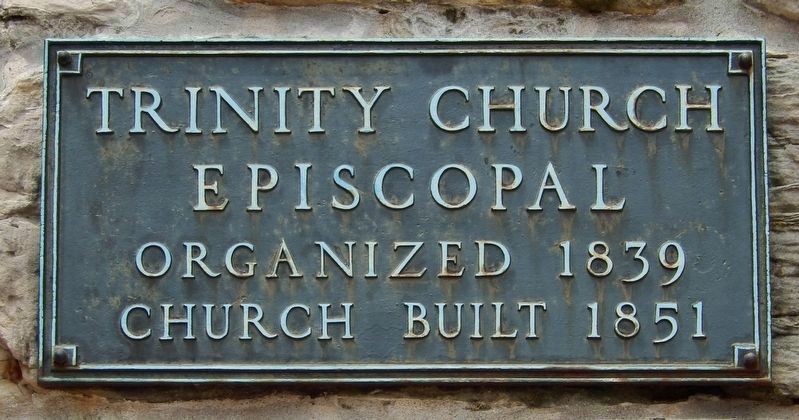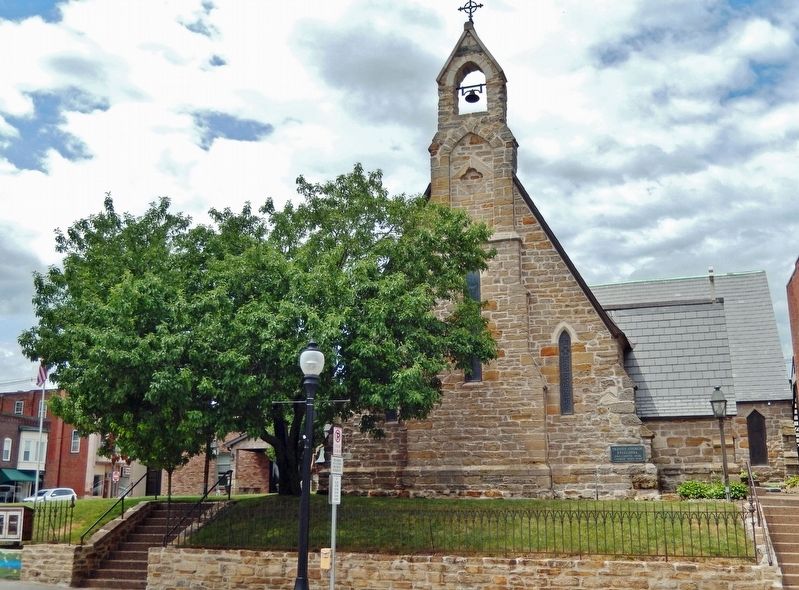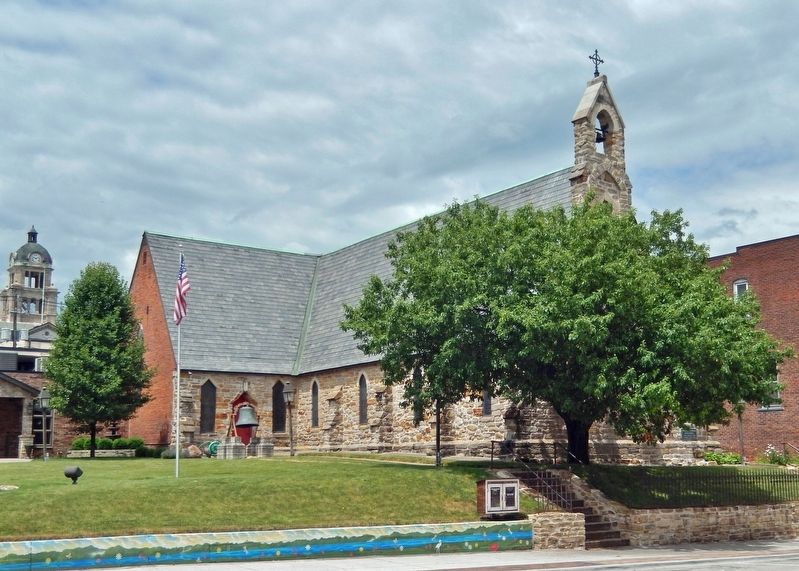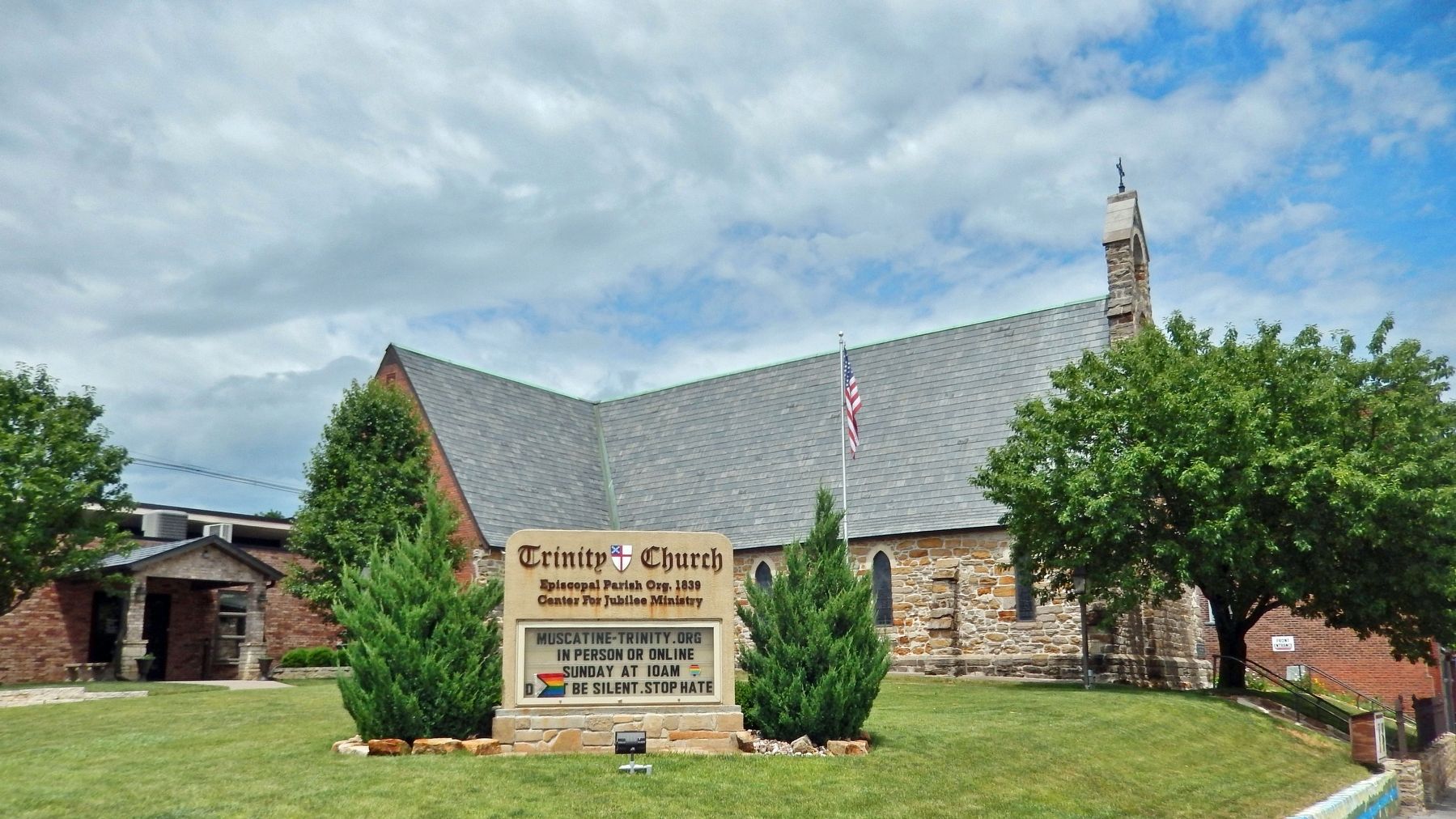Muscatine in Muscatine County, Iowa — The American Midwest (Upper Plains)
Trinity Episcopal Church
Church built 1851
Topics and series. This historical marker is listed in these topic lists: Architecture • Churches & Religion • Notable Buildings • Settlements & Settlers. In addition, it is included in the National Register of Historic Places series list. A significant historical year for this entry is 1851.
Location. 41° 25.405′ N, 91° 2.534′ W. Marker is in Muscatine, Iowa, in Muscatine County. Marker is on East 2nd Street just west of Mulberry Avenue (Business U.S. 61), on the right when traveling west. The marker is mounted at eye-level, directly on the subject building, near the right/east edge of the south façade. Touch for map. Marker is at or near this postal address: 411 East 2nd Street, Muscatine IA 52761, United States of America. Touch for directions.
Other nearby markers. At least 8 other markers are within walking distance of this marker. Muscatine Journal (about 400 feet away, measured in a direct line); Muscatine County All Veterans Memorial (about 400 feet away); Address by President Lincoln (about 500 feet away); Carry A. Nation (about 500 feet away); Old Jail (about 700 feet away); Replica of the Statue of Liberty (about 800 feet away); Papoose Creek (approx. 0.2 miles away); Mississippi River Record Flood Crest (approx. 0.2 miles away). Touch for a list and map of all markers in Muscatine.
Regarding Trinity Episcopal Church. National Register of Historic Places #74000803. Also a contributing property in Downtown Commercial Historic District (NRHP #06000423).
From the National Register Nomination: Trinity Episcopal Church in Muscatine is a Gothic Revival building of colorful sandstone laid in random ashlar fashion with raised mortar joints. Its plan is a cruciform with a prominent east gable end with bell tower. The gable roof is slate. The building is small in scale as are all openings ranging in shape from lancet to round to miter arches. While the significance of this stone church lies primarily in its architecture, the site also possesses considerable historical significance. Trinity parish is reputedly the oldest parish in the Episcopal diocese of Iowa. Tradition holds that when Iowa Episcopal priests gathered at Muscatine in 1853 to organize the Episcopal Diocese of the Iowa Territory, it took place at the new Trinity Church.
Also see . . .
1. Trinity Episcopal Church (Wikipedia). Excerpt:
The Episcopal Church in Muscatine can trace its roots to the arrival of Matthew Matthews, his son Dorrance, and his brothers Hiram and Joseph, and their families in 1839 when the town was named Bloomington. They were visited by the Rt. Rev. Jackson Kemper, Missionary Bishop of the Northwest, the same year and the congregation was organized. It is the first Episcopal parish organized in Iowa. The Rev. John B. Calhoun, who came to Trinity in 1850, asked parishioners to subscribe towards a new church building. Frank Will, an architect from New York City, was chosen to design the new church. The basement and foundations were built in the fall of 1851 and the cornerstone was laid on November 11. Construction on the church took three years. It is built of sandstone in the Gothic Revival style.(Submitted on January 2, 2024, by Cosmos Mariner of Cape Canaveral, Florida.)
2. Trinity Episcopal Church History. Excerpt:
The first Trinity Episcopal Church, along the Mississippi River in Muscatine, Iowa, was completed in late fall 1841. Jackson Kemper, the first Episcopal Missionary Bishop in the country, visited Bloomington (now Muscatine) while the wood framed, two-story church was being constructed under the leadership of Matthew Matthews. These founders completed the first Episcopal Church in Iowa. (Trinity was also the first church building in Muscatine County).(Submitted on January 2, 2024, by Cosmos Mariner of Cape Canaveral, Florida.)In 1851 a group of members raised $2,500 to construct a new stone church at the same location near the corner of Walnut Street and Second Street in Muscatine, Iowa where we still
proudly stand today. The existing church's cornerstone was laid on November 11, 1851.
3. Downtown Commercial Historic District (Wikipedia). Excerpt:
The city of Muscatine was established as Bloomington in 1836. Muscatine's commercial and industrial center had developed in a 12-block area along Front Street, now Mississippi Drive, and 2nd Street between Pine Street and Mulberry Street by 1874. This area, represented by the Downtown Commercial Historic District, is the city's original commercial area. Within its boundaries is a large number of 19th-century commercial buildings. Contributing buildings include Trinity Episcopal Church (already individually listed on the National Register).(Submitted on January 2, 2024, by Cosmos Mariner of Cape Canaveral, Florida.)
Credits. This page was last revised on January 2, 2024. It was originally submitted on January 2, 2024, by Cosmos Mariner of Cape Canaveral, Florida. This page has been viewed 46 times since then. Photos: 1, 2, 3, 4. submitted on January 2, 2024, by Cosmos Mariner of Cape Canaveral, Florida.



